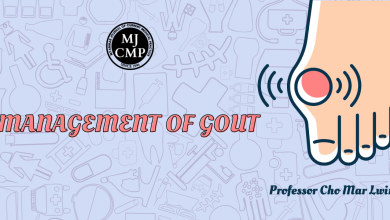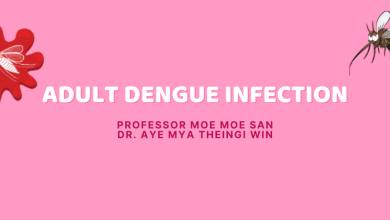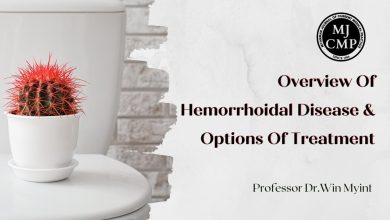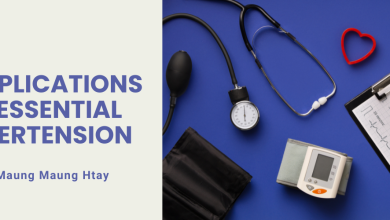Some Ethical Pitfalls In General Practice
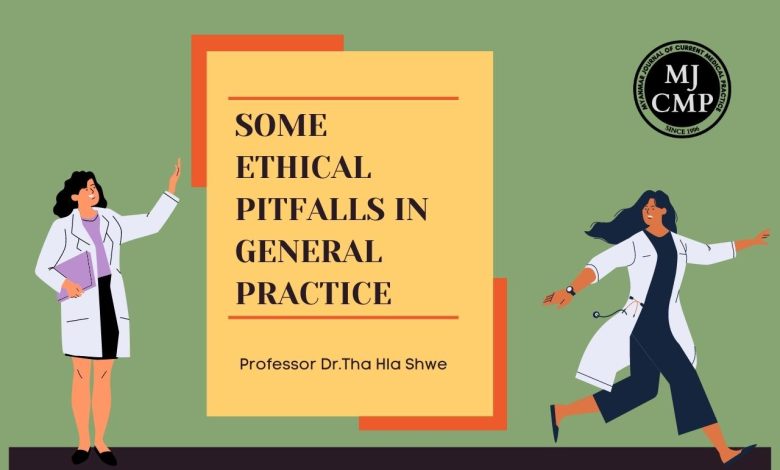
Ethics is the guiding principle in any professional practice. Medical ethics is an applied branch of ethics relating to clinical practice and scientific medical research. It is based upon a set of moral values which we can designate as Fundamental Principles. Basically they are four in number even though some more details can be added to each one of them. The four Fundamental Principles are:
- Beneficence – It is doing good and acting in the best interest of the patient. Beauchamp (2013) stated it means serving the interests of not only the patients but also that of their families. It means that we should view the patients as a whole person living in his/her family environment and our decisions should also take the family welfare into consideration. Myanmar Medical Council pointed out that to provide “good medical care” medical practitioners need to be “sufficiently educated” so as to be competent in their respective fields.
- Non-maleficence –The concept is not to cause harm to the patient, embodied by the phrase “first, do no harm.”A lot of treatments (e.g., giving antibiotics) carry some risk of harm and it should only be given if the benefits outweigh the harmful effects that may arise.
- Autonomy–Patients have the right and freedom to refuse or choose their treatment. To be able to do so, patients must have adequate knowledge of the treatment that will be given and the possible alternatives, all of which have to be provided by medical professionals, so that they can make informed decisions. This stood in sharp contrast to the historical “paternalism,” where doctors decide on behalf of the patients and their families. A point to take into consideration is the educational status and mental facultyof the patients and their families.
- Justice – Concerns with the decision as to distribution of health resources so that it is fair and equitable. The need for this principle became more eminent when the resources are scarce. Covid 19 vaccination is a very good example at the moment as the availability of vaccines will be quite limited, at least in the initial phase, so that prioritization is needed to decide who gets it first. As pointed out by the Myanmar Medical Council, there is a “need to work with the resources available (distributive justice), with respect for people’s rights (rights justice) and in accordance with the existing laws of the country (legal justice).”
Under these Fundamental Principles, one may also consider values such as Human Rights, Informed Consent, Confidentiality and Conflicts of Interest. They will be discussed based upon the practices that may be observed in the day-to-day work of the medical clinics. It needs to be mentioned that the practices stated here are not the usual practices observed in our clinics in Myanmar. Even if some existed, they will be few and far between. Many of them were observations cited in articles and texts on medical ethics. Some may even be taken as hypothetical ones presented solely for discussion.
Patients come to medical clinics expecting cure or relief from their medical problems and in the case of private clinics, they wants value for their money. They want relief/cure immediately if possible or as soon as possible. Sometimes the attending physician, wanting maybe to please them, or maybe because of being unsure about the cause of illness, would use what is called “shotgun therapy,” prescribing many drugs, antibiotics in case of infections, hoping one drug will be effective. These drugs, all with their side effects, pose serious risks to the patient, developing drug resistance, which may be the least of them. It may also happen that corticosteroids are given together with other drugs so as to get a dramatic response. In such instances both Beneficence and Non-maleficence principles were being violated.
Another possible ethical pitfall can be seen in the relationship doctors have with the drug companies. It is only logical that drug companies would like to promote the use of the drugs they are producing or marketing. Companies would have their representatives lobby with doctors, sometimes providing gifts, sponsorship for their travels locally and abroad, golf rounds, etc., etc. If doctors accept such gifts from companies it may naturally influence their decisions in selecting drugs for treatment. If it happens that the chosen drug is not as effective as another or have more serious side effects, then violation of ethical principles would come in. The Principles involved would be Beneficence, Non-maleficence arising out of conflicts of interest between the interest of patients and that of drug companies. To prevent conflicts of interest and lessen the influence of drug companies marketing upon medical practice, Wikipedia (2020) stated that Stanford University banned drug company-sponsored lunches and gifts. A number of American academic institutions have also banned such activities.
In Myanmar, up to a decade ago instances of patients/patients’ families suing doctors were very rare indeed. However, such litigations are becoming quite common nowadays. Maybe that is one of the reasons why doctors tend to carry out a more or less complete set of medical investigations, whether relevant for the presenting disease or not, which may pose a burden on the patients. By doing so doctors can now say they have done everything to treat the illness when they have to appear in court. Maybe the practice of providing commission by medical laboratories to doctors referring for medical tests could be the reason such referrals. Citing the findings of Swedlow et al. (1992) Wikipedia (2020) stated “Doctors who receive income from referring patients for medical tests have been shown to refer more patients for medical tests.”
The Principle of Autonomy delegates the decision to accept or refuse the intended treatment by the patient or patient’s family necessitate the need for them to be well informed about potential benefits and risks of various treatment regimens. This brought in the concept of “informed consent” which relates to the Autonomy principle. As stated previously it may prove to be a big challenge depending upon the patient/family educational status and mental faculty. It will be up to the doctor to explain as much as possible about the intended treatment and hope to get consent to accept it. The Autonomy principle will be violated if the doctor failed to provide adequate information to the patient and the family so that they can make an informed decision. Another attribute of Autonomy is “truth telling.” Patients have the right to know the truth about their illness, the good and the bad. However, in case of a patient who is dying and who is known to be really afraid of dying, asking the question “Am I going to die doctor?” it may be acceptable to tell a “White Lie” (e.g., Its possible but I don’t think so) which may provide some solace to the patient. Human rights may also form a part of Autonomy (The right to know, the right to make decisions) but may also be a part of Justice (The right to be treated with dignity, respect and as equal). Human rights is coming to the forefront of many things we do and is gaining space as one of the concepts we value in medical ethics. Sometimes the attending physician may unintentionally violate human rights simply by not answering patient’s questions and cutting him off abruptly.
Confidentiality is also a concept observed and valued in medical practice. All practitioners will have to face it inevitably at one time or another. Conversation between doctors and patients forms a pact between them known as patient – physician privilege. The patient information may not be revealed even in a court of law. This privilege poses a problem for the physician sometimes when it had to be judged against Beneficence and Non-maleficence. If a patient has sexually transmitted disease, the worst being HIV, and do not want the doctor to disclose it to his spouse, then the doctor is in a very difficult position. If he tells the spouse he will be violating confidentiality, but, if he does not then he will be violating Non-maleficence as she will be getting the disease. Also if he does not tell the spouse then Beneficence may also be violated as his behavior is not in the best interest of the spouse and the family. What should be done?
Another pitfall is doctors having sexual relationship with the patients. This amounts to professional misconduct and is strictly prohibited in nearly all countries. Even examining a private part of a patient (e.g., the breast of a girl) in the absence of any indication may amount to sexual misconduct. In such a situation, doctors may lose their medical license and may also be prosecuted. This is very clearly stated in the booklet “Ethics and Code of Professional Conduct for Medical Practitioners” published by Myanmar Medical Council (2020). This type of relationship is concerned not only with the patient but also with spouse and immediate family members. This misconduct would fall under the Justice principle as legal implications will be involved.
An ethical misconduct that can easily happen is in examination and treatment of women and girls without the presence of a family member (if the patient desired it) or a Chaperone (a person who acts as a witness for a patient and a health professional during a medical examination or procedure). Chaperone is the term used by the Myanmar Medical Council (MMC) in their publication. MMC also stated that “This is to promote respect and dignity of the patients in the professional nature of the examination,” and also that “The presence of a chaperone may also provide protection to health professionals against unfounded allegations of improper behaviour.” As such, this practice will be concerned with human rights and would come under the Autonomy principle.
These are some of the ethical pitfalls which can happen unintentionally in general practice, and they are certainly not exhaustive. The MMC booklet mentioned previously contains quite a detailed list of conduct required of medical practitioners in Myanmar. It covers nearly all aspects of general practice, even going into the use of social media and telemedicine. It is indeed a booklet which all general practitioners should read and use as a guide in their practice so that they become more worthy professionals.
Sources
- Myanmar Medical Council (2020), Ethics and Code of Professional Conduct for Medical Practitioners, 2nd Edition.
- Wikipedia, Medical ethics, downloaded from the Internet, https://en.wikipedia.org/wiki/Medical_ethics downloadedon13September2020.
- Beauchamp, J. (2013).”Principles of Biomedical Ethics”. Principles of Biomedical Ethics. 7.
Cited in Wikipedia above. - Swedlow A, Johnson G, Smithline N, Milstein A (1992). “Increased costs and rates of use in the California workers’ compensation system as a result of self-referral by physicians”. N.Engl J Med. 327(21): 1502-6. doi: 10.1056/NEJM199211193272107 (https://doi.org/10. 1056%2FNEJM199211193272107). Cited in Wikipedia above.
Author Information
Tha Hla Shwe
Rector (Retd),
University of Medicine (2), Yangon


